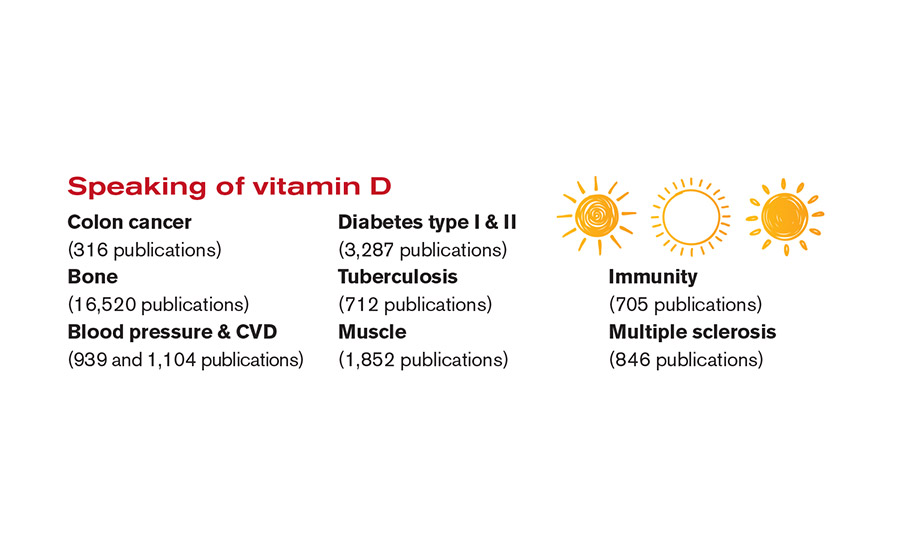More than 90% of Americans do not get their Estimated Average Requirement (EAR) for vitamin D, according to the Scientific Report of the 2015 Dietary Guidelines Advisory Committee. Long recognized as important for healthy bones, vitamin D is now recognized as having multiple benefits beyond bone health. Dairy producers and processors need to do more to promote milk, the leading source of vitamin D in the U.S. diet, and to fortify additional dairy foods with this critical nutrient.
In 2014, there were over 4,500 articles published in PubMed on vitamin D, and there are currently more than 1,000 ongoing human studies on the vitamin.
“Focus areas for research include type I and II diabetes, blood pressure and cardiovascular disease, muscle health, multiple sclerosis (MS), immunity and colon health,” said Manfred Eggersdorfer, DSM’s Senior Vice President Nutrition Science and Advocacy, in a webinar on the topic.
Benefits of vitamin D
Suboptimal levels of vitamin D in infancy and childhood are a potential risk factor for autism spectrum disorders and for adult cardiovascular disease. Higher levels of vitamin D are associated with lower risk of lung cancer, early treatment of MS and reduced risk of sarcopenia in post-menopausal women. An article in JAMA found that low levels of vitamin D are associated with “profound” and “rapid” cognitive decline.
In addition to dietary sources, vitamin D is also produced by the skin when it is exposed to sunlight, thus the nickname “the sunshine vitamin.” Vitamin D is converted to 25(OH)D in the liver. Adequacy is measured by evaluating dietary intake or by measuring 25(OH)D levels in the blood.
For adults, the EAR and the Daily Value (used on food labels) for vitamin D is 400 IU/day. The Recommended Dietary Allowance is 600 IU/day for individuals ages 1 through 70, and 800 IU/day for men and women over 70. Most children 1 to 3 consume the recommended intake of dairy, but consumption drops off rapidly in teens and adults.
According to the Dietary Guidelines report, “Dietary intake of vitamin D in the United States is low and well below the EAR values for all age and sex groups.”
The committee has designated vitamin D as a nutrient of concern, and the report calls for broadening the range of dairy products that are fortified. The FDA has proposed changes to the Nutrition Facts panel. If approved, vitamin D will become a required nutrient in the new format. It is not certain when the new regulation will be finalized and take effect.
Fortifying yogurt, butter, cheese
In the United States, fortification of milk and other dairy products is permitted. Milk has traditionally been recognized as an excellent source of vitamin D, but many dairy foods that are eligible for fortification are not currently being fortified, and many of those products don’t promote their vitamin D content with a label claim.
“Currently 94% of milk sold in the U.S. is fortified with vitamin D. Only 54% of yogurt is fortified, and that level is down from 68% in 2010. Fortification of butter and cheese is low. Market insights data, however, has shown a steady increase of new product innovations showing a “vitamin D” label claim within the yogurt segment, including drinking yogurts and fermented beverages,” said Rohit Kapoor, vice president of product research at the National Dairy Council.
There are a few success stories. Kraft promotes the vitamin D content of Kraft Singles on its website. Finland is a compelling example of a country that used a mandatory fortification program to improve the vitamin D status of its population.
Certain fatty fish contain the highest levels of vitamin D. Other foods that are eligible for fortification include calcium-fortified fruit juices and drinks, breakfast cereals, and enriched rice, corn meal, noodle and macaroni products. The vitamin D council suggests that it’s difficult to get vitamin D from foods, and consumers should turn to the sun and supplements. Dairy proponents and marketers should take note and continue to promote dairy as a vehicle for vitamin D. If dairy doesn’t step up to the plate, other food categories or supplements will emerge as the preferred delivery vehicle for this important nutrient.



